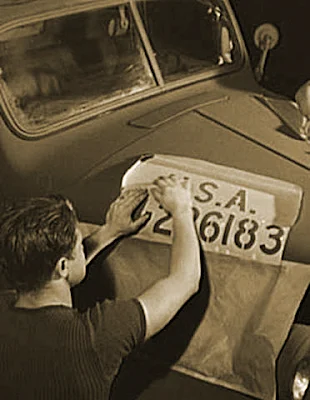 |
| Stencils for blue-drab lusterless enamel hood numbers are applied to Dodge trucks at the Detroit factory during World War II. |
The following material is reprinted from Circular No. 74, War Department, Washington, D.C., dated 17 April 1941, which provided for changes in Army Regulations AR 850-5 of 25 September 1936 as pertaining to the marking of U.S. registration symbols and numbers.
Naturally, these regulations were subject to local interpretation by the unit, its commander, and even the men who applied the markings, etc. Hence, these regulations can only be considered as guidelines. There would actually have been considerable variety among the actual vehicles in the field, so modelers should not worry too much about following such “official regulations” to the letter.
Also, note that the material reprinted here are merely the changes made to the original AR 850-5, which were done in preparation for the—by then—very real possibility of America being pulled into the European war then well underway. Thus, the material here must be used together with the still in effect portions of AR 850-5 to acquire a complete picture of U.S. Army vehicle painting and markings.
•
The marking on the vehicle will be with blue-drab lusterless enamel by means of a stencil, and on U.S. registration plates by a metal stamping device and blue painted figures as indicated in AR 850-5.
The marking required above will be placed on the outside of the vehicle except where otherwise indicated as per marking diagram:
Passenger Cars
All letters and figures will be placed under the hood, on the right side, in center of upper part, and on registration plates, front and rear.
Ambulances, Metropolitan
Same as passenger cars.
Ambulances, Field
On the outer surface of the hood, both sides, and also the rear doors.
Motorcycles (Both Solo and those with Side Cars)
On registration plates, rear only.
Trucks
On the outer surface of the hood, both sides, and also on tail gate. For trucks without hoods, on each end of the driver’s seat, and also on tail gate.
Reconnaissance Trucks
Same as trucks.
Panel and Sedan Delivery
Same as ambulances, field.
Trailers
In the center of the back.
Additional Details
Side, front, and rear markings are required only on vehicles assigned to units.
Side markings will be done by means of a stencil, using blue-drab lusterless enamel. Capital letters will be 3 inches in height, when the available space permits; otherwise, of a size appropriate to the space available. The height of small letters will be half that of capital letters. The numerical designation of regimental unit (or other unit) is to be displayed in Arabic numerals, followed by the component within the unit. Examples: 39th Inf. Co. F, 105th QM Regt. Co. A, 1st Armd. Regt. Co. A.
Front and rear markings will be stenciled with blue-drab lusterless enamel on olive drab lusterless enameled plates similar to state license plates, or, if plates are not suitable for the type or use of the vehicle, this marking will be placed on the lowest space available on the left rear surface of the body or tail gate, whichever is lower.
Insignia of arms, services, and bureaus requirements was rescinded.
The markings on recruiting service vehicles (Army Recruiting Service) will be marked on the sides and rear of the body with dark blue block letters U.S. ARMY RECRUITING SERVICE at least 3 inches in height, and with the insignia of the Adjutant General’s Department in approved colors in the center of the front door panels and in the middle of the rear below the lettering. On mobile recruiting stations (trailers), the lettering will include the words MOBILE STATION NO. ____, and the insignia will be placed in the middle of the sides and rear below the lettering.
All paints used in marking ambulances will be of lusterless synthetic enamel of the proper colors prescribed above.
No markings other than those provided for above will be permitted, and bumpers, headlight rims, etc., will be kept painted with olive drab lusterless enamel.
 |
| This is a page reproduced from Circular No. 74. |
 |
| This is a page reproduced from Circular No. 74. |
 |
| This is a page reproduced from Circular No. 74. |
 |
| This is a page reproduced from Circular No. 74. |
 |
| This is a page reproduced from Circular No. 74. |
 |
| M3E3 Light Tank with registration number in blue-drab lusterless enamel on the rear hull side, 19 March 1942. |
 |
| Another view of the same tank. |
 |
| Another view of the same tank. |
 |
| Faintly visible in this enlargement of the rear hull side of the previous photo is the “USA” and a registration number below that in blue-drab lusterless enamel. |
 |
| Personnel belonging to a Medical Detachment (attached to an Armored unit) are being transported in an M3A1 Scout Car. |
 |
| 11Δ 42Δ SV-61 — Captured German RSO (Raupenschlepper Ost) tractor with markings for vehicle 61 of Service Company, 42nd Tank Battalion, 11th Armored Division. |
 |
| 3A-34M EV-24 — Truck from 34th Evacuation Hospital, Third Army, marked according to regulations. |
 |
| TSF BP 382P HQ — Jeep of the Military Police, Theater Service Forces, with complete unit markings. This photograph is most likely a post-war photograph taken during occupation duty. |
 |
| 102-406-I MED-4 — A jeep and trailer from the Medical Detachment of the 406th Infantry Regiment, 102nd Infantry Division carry regulation markings. |












No comments:
Post a Comment